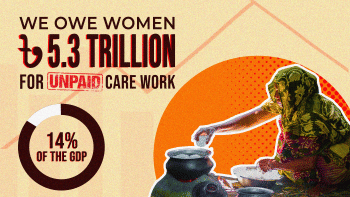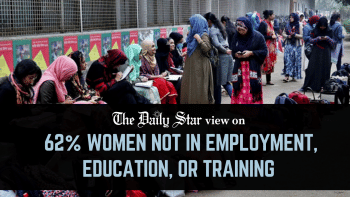More women in construction sector should be our next goal

Bangladesh's economy has witnessed remarkable growth, solidifying it as one of the fastest growing economies worldwide. According to the Bangladesh Economic Review 2023, the construction sector significantly contributes to this growth—approximately 6.41 percent in 2023. Construction's share within the industry sector and growth is on the rise, with the growth rate increasing to 8.71 percent in FY2021-22, compared to 8.08 percent in FY2020-21.
As the construction sector expands, it demands more labour. According to the Labour Force Survey 2022, construction is the fifth largest industry in terms of employment in Bangladesh, with about 5.44 percent of the employed population working in this sector. A study conducted by Bangladesh Institute of Development Studies (BIDS) projects that the construction industry is expected to require approximately 90 lakh workers by 2030. But among the top five employment-generating industries, the construction sector ranks second to last in terms of female employment. Only 0.4 percent of women are employed in this sector, compared to 8.18 percent of men. With female labour force participation in Bangladesh increasing from 36.3 percent in 2016-17 to 42.7 percent in 2022, the expanding construction sector presents a significant opportunity to accommodate more female workers.
Additionally, with the country's LDC graduation and the anticipated decline in RMG exports, exploring sectors like construction is crucial for accommodating the expected structural shift in labour dynamics. The rise of automation and Fourth Industrial Revolution (4IR) technology highlights the need to focus on technology and skills-based occupations for women.
According to the Labour Force Survey 2016-17, females in the construction sector are primarily concentrated in lower tier jobs: 31.23 percent as civil engineering labourers, 22.15 percent as building construction workers, and 18.27 percent as bricklayers. Studies found that women also work in senior management and administrative roles, accounting for approximately 7.1 percent and 4.3 percent of total female employment in the sector, respectively. Across all occupations, most female workers are either unskilled (53 percent) or semi-skilled (17 percent). According to the findings in the Construction Industry Skills Council (CISC) Employers surveys in 2018 and 2020, female workers are considered less productive than males.
The construction sector is highly informal; 78.42 percent of female workers are employed as per verbal agreements. Only 0.3 percent of female employees have access to toilets and sanitation facilities, and 1.88 percent have maternity leave benefits. This sector is inherently hazardous due to the nature of its work, yet only one percent of female workers have access to safety gear. Additionally, just 0.78 percent receive transportation and food subsidies, and 0.66 percent benefit from daycare facilities.
Despite policies to boost women's participation in the labour force, there are no gender-specific policies in the construction sector. The Public Procurement Rule, 2008, and Occupational Health and Safety Policy, 2013 ensure workplace safety but lack gender provisions. The labour law addresses critical women's issues like hygiene, maternity leave, medical facilities, and working hours, but enforcement is challenging in informal sectors like construction.
Women are largely confined to unskilled jobs like brick-breaking and excavation due to a substantial skills gap and lack of access to training programmes. The sector's high informality—characterised by irregular recruitment, work hours, and payment methods—limits job stability. Additionally, mobility and transportation issues, coupled with inadequate on site infrastructure and security concerns, deter women from long term-roles. The work environment is often abusive, with frequent conduct violations, resistance to female leadership, and harassment. Unsafe conditions and inadequate accommodations, such as the lack of separate bathrooms and resting areas, further exacerbate these difficulties. Gender based violence, including sexual harassment and physical assault, remains a significant barrier, with limited avenues for complaint. Wage exploitation is prevalent, with female workers often paid less than their male counterparts for similar work. Societal norms and gender bias further discourage female participation, with industry stakeholders perceiving women as less productive and costlier due to additional safety and security needs. Barriers related to marriage, pregnancy, and care work, combined with a lack of role models and representation in workers' unions, further limit women's opportunities and perpetuate their marginalisation in the construction sector.
To increase female participation and to create a more inclusive environment in the construction industry, several essential actions should be taken to overcome the challenges. Firstly, establishing a comprehensive workforce database, gradually formalising the sector through structured recruitment, fair wages, standard work hours, proper implementation of well-defined health, safety, and compensation policies, and an institutional body addressing workplace abuse and harassment are crucial.
Secondly, promoting female participation through skills training incentives and creating a gender responsive ecosystem with standard wages, safety measures, maternity benefits, and flexible work hours are also extremely important. Ensuring that training programmes include 30 percent female participation as mandated by the government and declaring minimum wages for entry-level jobs should be considered.
Thirdly, streamlining the labour hiring processes for contractors and subcontractors, maintaining a worker database with national ID numbers to identify wage gaps, and adding specific clauses to labour laws addressing the construction sector-related concerns are vital. The Ministry of Women and Children's Affairs should play a significant role in this regard, with private actors and labour organisations advocating for workers' needs. Finally, state owned insurance companies should offer workers injury packages.
The construction sector has the potential to increase female workforce participation, ensuring gender parity and aligning with three Sustainable Development Goals (SDGs 1, 5, and 8). Occupations in this sector are predominantly male-centric across all tiers, underscoring gender bias and stigma, necessitating considerable attention from the government and policymakers. Implementing the above recommendations can help make the construction sector a leading example of gender parity and inclusivity, driving sustainable development and economic progress in Bangladesh.
Dipa Das is research associate at South Asian Network on Economic Modeling (SANEM).
Eshrat Sharmin is senior research associate at SANEM.
Views expressed in this article are the author's own.
Follow The Daily Star Opinion on Facebook for the latest opinions, commentaries and analyses by experts and professionals. To contribute your article or letter to The Daily Star Opinion, see our guidelines for submission.

 For all latest news, follow The Daily Star's Google News channel.
For all latest news, follow The Daily Star's Google News channel. 





Comments